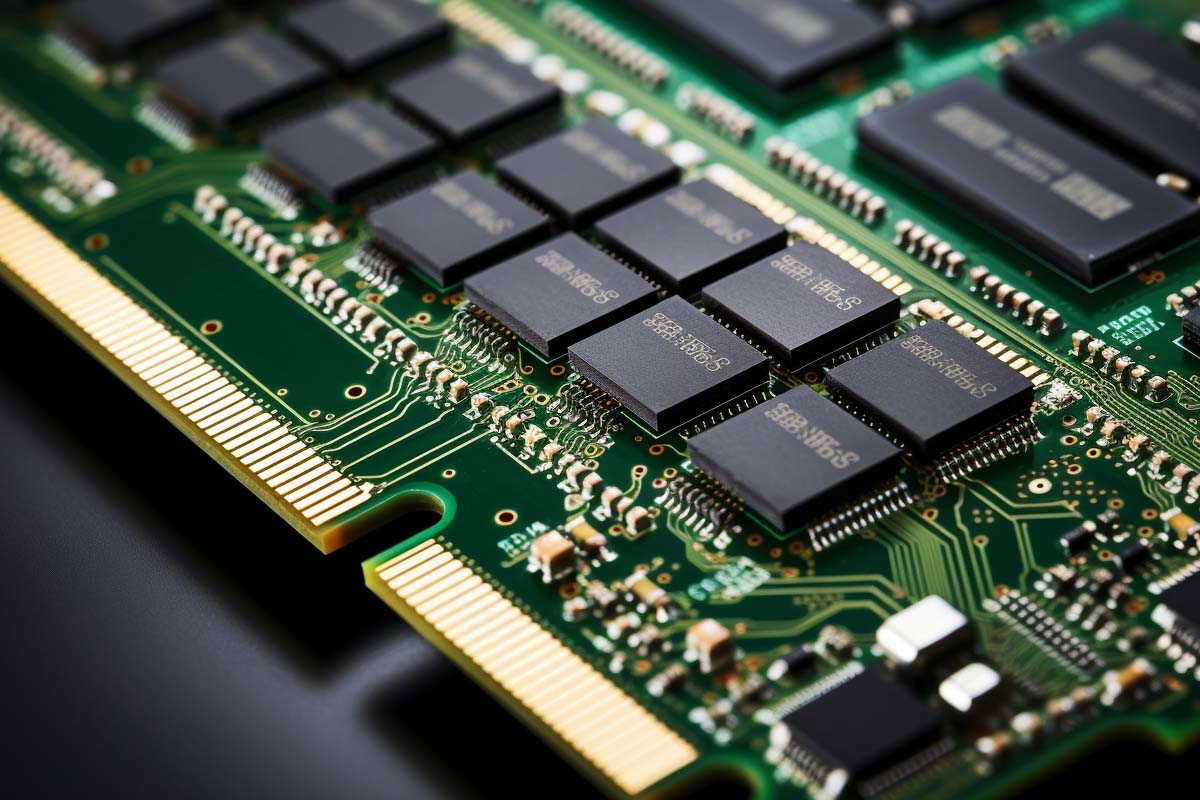What Is Off-Page SEO?
Definition: Off-Page SEO Off-Page SEO refers to all the activities performed outside a website to improve its search engine rankings. It involves strategies such as link building, social media marketing,

In this blog, let’s delve into the evolution of DDR Memory, focusing particularly on the latest advancements by comparing DDR4 vs DDR5. DDR, which stands for Double Data Rate, represents a pivotal type of SDRAM (Synchronous Dynamic Random-Access Memory) utilized in an array of computers and devices to facilitate swift data transfers. The innovation of DDR technology lies in its ability to transfer data on both the rising and falling edges of the clock signal, a feature that effectively doubles the memory’s data rate without the need to increase the clock frequency. As we explore the differences and improvements brought forth by DDR4 vs DDR5, we’ll gain a clearer understanding of how these technologies stand to revolutionize performance and efficiency in computing environments.
DDR memory has evolved through several generations, each improving on the last in terms of speed, efficiency, and performance.
The table below displays the differences between various generations of DDR (Double Data Rate) SDRAM (Synchronous Dynamic Random-Access Memory) and will help illustrate how each generation has evolved in terms of technology and performance. Here’s a simplified overview that compares DDR, DDR2, DDR3, DDR4, and DDR5, focusing on key attributes like speed, voltage, and other significant features.
| Feature | DDR (DDR1) | DDR2 | DDR3 | DDR4 | DDR5 |
|---|---|---|---|---|---|
| Introduction Year | 2000 | 2003 | 2007 | 2014 | 2020 |
| Speed (MT/s) | 200-400 | 400-800 | 800-1600 | 2133-3200+ | 4800-8400+ |
| Voltage | 2.5V | 1.8V | 1.5V | 1.2V | 1.1V |
| Prefetch Buffer | 2n | 4n | 8n | 8n | 16n |
| Data Rate (GB/s) | 1.6-3.2 | 3.2-6.4 | 6.4-12.8 | 17-25.6+ | 38.4-67.2+ |
| Module Name | PC1600 – PC3200 | PC2-3200 – PC2-6400 | PC3-6400 – PC3-12800 | PC4-17000 – PC4-25600 | PC5-38400 – PC5-67200 |
| CAS Latency (Clocks) | 2-3 | 3-5 | 7-14 | 10-20 | 22-40+ |
| Key Features | First DDR technology | Lower voltage, improved speed over DDR | Further reduced voltage, higher speeds, improved efficiency | Higher speeds, improved power efficiency, increased density | Significantly increased speeds and bandwidth, improved power efficiency, higher density, on-die ECC |
Note: The speeds, voltages, and other specifications can vary depending on the specific modules and manufacturers. The data rates and CAS latencies listed are typical ranges and may not encompass all available options for each DDR generation.
This table highlights the continuous advancements in memory technology, showing how each new generation improves upon the last in terms of speed, efficiency, and overall performance.

View our comprehensive training series covering all the key elements and certifications needed to successfully excel in an IT User Support Specialist job role.
DDR memory is a crucial component in computing, directly affecting the speed and performance of systems. As technology progresses, newer generations of DDR continue to push the boundaries of what’s possible in computing performance, energy efficiency, and system capabilities.
Since its debut in 2014, DDR4 has set the benchmark in RAM technology, eclipsing its predecessor, DDR3, with advancements in speed and power efficiency. These improvements are not just incremental; they represent a substantial leap forward. DDR4 introduced enhancements like superior data transfer rates, with base speeds starting at 2133 MT/s (Millions of Transfers per Second) and extending up to 3200 MT/s or even beyond with overclocked units. Additionally, it demanded lower voltage, significantly boosting memory bandwidth and overall system performance while curbing power consumption. This combination of features made DDR4 the industry standard, ideally suited for a broad spectrum of computing requirements, from consumer electronics to enterprise-level applications. As the computing world evolves, the transition from DDR4 to DDR5 is eagerly anticipated, promising even greater efficiency and performance enhancements.
DDR5, the forefront of RAM innovation, is poised to reshape our expectations of system memory. Officially stepping onto the stage in 2020, DDR5 not only aims to double the data rates that DDR4 provided, with initial speeds kicking off at 4800 MT/s and the potential to soar up to 8400 MT/s or beyond as the technology advances, but it also brings a host of other enhancements to the table. This leap from DDR4 to DDR5 represents a significant evolution in memory technology, with DDR5 offering not just a dramatic increase in speed but also advancements in power efficiency, greater capacity per module, and innovative features aimed at minimizing latency and bolstering the reliability of data transfers. These improvements are crucial for meeting the growing demands of modern computing, from high-end gaming to complex professional workloads, marking a pivotal shift in how performance and efficiency are understood in the context of system memory.
The transition to DDR5, the latest generation of RAM, is a comprehensive upgrade that extends beyond merely replacing memory modules. This shift necessitates motherboard and processor compatibility with DDR5, indicating that moving to DDR5 often entails a significant system overhaul. Although DDR5 comes with enticing enhancements over its predecessor, DDR4, including potential for higher speeds, greater efficiency, and increased capacity, the rate at which it will be adopted hinges on the availability of hardware that supports DDR5 and the cost comparison between DDR4 vs DDR5 modules. This cost-performance analysis is crucial for both consumers and enterprises as they navigate the upgrade path from DDR4 to DDR5, balancing the cutting-edge benefits against the practicalities of system compatibility and overall investment.

In partnership with Udemy and Vision Training Systems, get the newest A+ training course at the best price
The updated 220-1201 & 220-1202 exams deliver cutting-edge skills for today’s tech-driven world—covering essential hardware, software, networking, and security knowledge.
When comparing DDR4 vs DDR5, it’s essential to understand the evolutionary leap that DDR5 represents in the realm of memory technology. DDR5 offers significant improvements in speed, efficiency, and capacity, marking it as a substantial advancement over DDR4. These enhancements are poised to benefit a wide array of computing applications, from immersive gaming experiences to demanding professional workloads. As the industry transitions from DDR4 to DDR5, the pace will be gradual, dictated by a variety of factors including cost, hardware compatibility, and the diverse requirements of users.
For individuals assembling new systems or contemplating upgrades in the near term, DDR5 offers a compelling preview of the future of computing performance. It heralds a new era of speed and efficiency that will eventually become the standard. However, DDR4 remains a robust and efficient choice for many, striking an optimal balance between cost and performance for current computing demands. The decision between DDR4 vs DDR5 ultimately hinges on evaluating the trade-offs between the cutting-edge advancements of DDR5 and the established reliability and cost-effectiveness of DDR4.
DDR5 RAM offers significantly higher data transfer rates, starting at 4800 MT/s compared to DDR4’s starting speed of 2133 MT/s. DDR5 also operates at a lower voltage (1.1V) compared to DDR4 (1.2V), enhancing power efficiency. Additionally, DDR5 supports larger capacities per module and introduces features like on-die ECC (Error Correction Code) to improve data reliability.
No, DDR5 memory cannot be used in a DDR4 motherboard. DDR4 and DDR5 use different key notches (physical layouts) and electrical interfaces, making them incompatible with each other’s sockets. An upgrade to DDR5 memory would require a motherboard that specifically supports DDR5 RAM.
The answer depends on your specific needs and usage scenarios. If you require the highest possible performance for applications like gaming, video editing, or data analysis, DDR5’s higher bandwidth and efficiency could offer noticeable improvements. However, for general computing tasks, DDR4 may still provide sufficient performance. Also, considering the cost and the need for compatible hardware (motherboard and CPU), it might be more cost-effective to stick with DDR4 for now if your current setup meets your needs.
DDR5 improves power efficiency through lower operating voltage (1.1V compared to DDR4’s 1.2V) and more advanced power management features. These enhancements allow DDR5 to achieve higher performance while consuming less power, which can contribute to lower energy costs and reduced heat generation in systems.
DDR5 has the potential to improve gaming performance, especially in scenarios where the CPU is heavily utilized, and memory speed becomes a bottleneck. The higher bandwidth and data rates of DDR5 can lead to smoother gameplay and faster load times in memory-intensive games. However, the extent of the improvement may vary depending on the specific game, the overall system configuration, and whether the CPU or GPU is the primary limiting factor in performance.
In participation with our Udemy Partner, enroll in the newest CompTIA A+ 2025 training course for only $12.99
Lorem ipsum dolor sit amet, consectetur adipiscing elit. Ut elit tellus, luctus nec ullamcorper mattis, pulvinar dapibus leo.
$49.99 Original price was: $49.99.$24.99Current price is: $24.99. / month with a 10-day free trial
Definition: Off-Page SEO Off-Page SEO refers to all the activities performed outside a website to improve its search engine rankings. It involves strategies such as link building, social media marketing,
The (ISC)² HCISPP (HealthCare Information Security and Privacy Practitioner) certification is a globally recognized credential that signifies an IT professional’s expertise in implementing, managing, and assessing security and privacy controls
An Access Point (AP), in the context of networking, is a hardware device that allows wireless devices to connect to a wired network using Wi-Fi, or related standards. The AP
Adaptive Bitrate Streaming (ABS) is a technology designed to deliver the best video and audio quality to the end-user while adjusting to the varying internet speeds. This dynamic streaming technique
Adaptive Web Design (AWD) focuses on creating multiple versions of a website to fit the user’s device, ranging from smartphones to large desktop monitors. Unlike responsive design, which fluidly changes
Advanced data visualization is a critical component in the analysis and communication of complex datasets. It refers to the techniques and tools used to create visual representations of data that
The Agile Development Framework is a methodological approach for software development that emphasizes flexibility, customer collaboration, and the ability to adapt to changing requirements. This approach breaks down projects into
Agile Release Management is a critical aspect of the software development process, focusing on the planning, scheduling, and controlling of software builds through different stages and environments, including testing and
Agile Test Data Management (ATDM) is a methodology focused on improving the efficiency and effectiveness of testing processes within an Agile software development environment. By integrating practices for managing test
The air interface is a critical concept in the telecommunications sector, particularly within the realms of mobile networks and wireless communication systems. This term refers to the radio frequency (RF)
Algorithmic complexity, also known as computational complexity, is a critical concept in computer science that pertains to the efficiency of algorithms. This efficiency is measured in terms of the time
Ambient Computing refers to the integration of digital technology into the environment around us in such a way that it operates in the background, seamlessly and unobtrusively assisting with daily